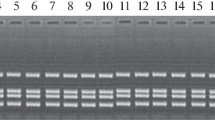Summary
-
1.
All the sesbania strains employed in these studies were strikingly similar to other well-known rhizobia as shown by a wide variety of tests involving a diverse collection of mineral salts media containing a variety of carbon and nitrogen sources.
-
2.
In comparative tests the 39 strains of sesbania rhizobia are divided into two well-defined groups. Those fromS. macrocarpa andS. longifolia, designated as Group 1, were culturally similar to the fast-growing rhizobia from clover, peas and beans. These strains produced mucilaginous colonies on all agar media, did not grow inHofer's alkaline media, veal infusion broth,Clark andLub's, Koser's uric acid andZoBell's media and did not reduce nitrate. Others fromS. grandiflora, S. tomentosa, S. aculeata andS. sesban, comprising Group 2, produced compact opaque colonies, grew in the above media and reduced nitrate slowly.
-
3.
Question is raised that Congo red agar is a completely reliable medium for the separation of rhizobia from closely allied bacteria, as judged by dye absorption.
-
4.
The strains of sesbania rhizobia showed considerable variation in their abilities to tolerate crystal violet in a peptone-sucrose medium. The majority of fast-growing strains of the designated rhizobial species did not grow in concentrations greater than 1∶10,000 crystal violet; none of the slow-growing strains tolerated concentrations above 1∶30,000. All the strains of species in the genusAgrobacterium resisted a 1∶2,500 concentration.
-
5.
Evidence is presented that a relationship exists between tolerance of rhizobial strains to crystal violet dye in media and their abilities to produce gum.
-
6.
Various cultural tests are described which permit reliable differentiations between rhizobia and related bacteria, exemplified by diverse strains ofA. tumefacines andA. radiobacter.
Similar content being viewed by others
Literature
W. A. Albrecht andT. M. McCalla, J. Bact.34, 455, 1937.
Ethel K. Allen andO. N. Allen, Bact. Rev.14, 273, 1950.
O. N. Allen, Experiments in Soil Bacteriology, Burgess Publishing Co., Minneapolis, Minn., U.S.A., 126 pp., 1949.
C. S. Bryan, Soil Sci.45, 185, 1938.
M. Damodaran andM. Srinivasan, Proc. Indian Acad. Sci.2B, 337, 1935.
C. E. Georgi andJane M. Ettinger, J. Bact.41, 323, 1941.
J. O. Harris, Unpublished Master of Science thesis, 86 pp., University of Hawaii, Honolulu, T. H.,1941.
A. W. Hofer, J. Bact.25, 56, 1933.
A. W. Hofer, J. Amer. Soc. Agron.27, 228, 1935.
A. W. Hofer, J. Bact.41, 193, 1941.
E. W. Hopkins, W. H. Peterson andE. B. Fred, J. Amer. Chem. Soc.52, 3659, 1930.
S. A. Koser, J. Infect. Dis.23, 377, 1918.
T. Matsuoka, Japanese patent 35952, March 11, 1920 (see Chem. Abs.15, No. 1406, 1921).
T. Rajagopalan, Indian J. Agr. Sci.8, 331, 1938.
M. S. Raju, Zentr. Bakt. II,94, 337, 1936.
A. J. Riker, W. M. Banfield, W. H. Wright, G. W. Keitt andH. E. Sagen, J. Agr. Res.41, 507, 1930.
A. J. Riker, Mary M. Lyneis andS. B. Loche, Phytopath.31, 964, 1941.
N. R. Smith, J. Bact.15, 20, 1928.
N. R. Smith andH. Humfeld, J. Agr. Res.41, 97, 1930.
C. E. ZoBell andCatherine B. Feltham, J. Bact.28, 169, 1934.
Author information
Authors and Affiliations
Additional information
Published with the approval of the director, Wisconsin Agricultural Experiment Station.
Rights and permissions
About this article
Cite this article
Johnson, M.D., Allen, O.N. Cultural reactions of rhizobia with special reference to strains isolated fromSesbania species. Antonie van Leeuwenhoek 18, 1–12 (1952). https://doi.org/10.1007/BF02538585
Received:
Issue Date:
DOI: https://doi.org/10.1007/BF02538585




